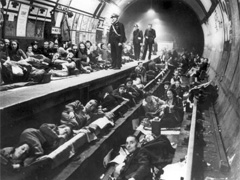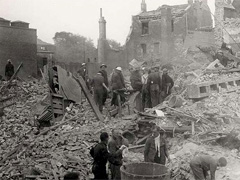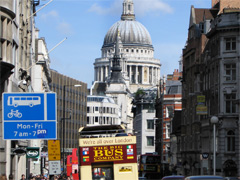


There have been accounts of the valiant efforts of people who tried to make the stations pleasant environments, with classes, amateur dramatics and entertainers performing to keep spirits up. But in reality these makeshift shelters were dangerously overcrowded and had the most unsanitary conditions.
The government was initially against the idea of using underground stations as air raid shelters, as they were worried large gatherings of people might slow down the trains, not to mention the loss of morale that could happen as a consequence of grouping hundreds of war refugees underground. If a bomb did strike somewhere with a large concentration of people there would be a huge loss of life, something that occurred on several occasions, such as at Bank station in 1941, when a direct hit resulted in 111 casualties as the blast detonated through the tunnels, killing almost 60 people.
Those fortunate enough to have a back garden could have an air raid shelter built there (these were free to people on low incomes) but only 25% of Londoners had their own patch of land at the time. Other alternatives were communal shelters and trench shelters in parks, such as the one in Kennington Park.
\n\nVauxhall was of particular interest to the Nazi bombers; as well as being a major transport hub there were many manufacturers based here - around 2,500 bombs were dropped on Vauxhall, Kennington and Lambeth in the war. It wasn’t possible to hide at the local tube stations; Oval had been prone to flooding while an attempt was made to construct a deep level shelter (more on those later), and had even been surrounded by barbed wire to prevent people entering. But shelters were needed, and a trench was constructed in Kennington Park, the outline of which can still be seen from the sky to this day.
The shelter was divided into grids, each with space for 50 people. Sanitation facilities were very basic, as the trench had only been designed to accommodate people for three to four hours at a time, when in fact stretches of twelve hours were not uncommon. There was a rank smell and a mouldy roof, which made it a deeply uncomfortable place to stay. Like most shelters of its kind, it couldn’t withstand a direct hit, and so when a bomb was dropped here over 100 people were killed. Half of the bodies were trapped in the rubble and never recovered, and had to be disposed of by being covered in lime.
Despite initial reluctance, once severe bombing in 1941 began, the government had to reappraise its position and decided to construct a number of deep level shelters connected to existing stations. The idea was that they’d remain open after the war ended for a new express railway, and so the new tunnels were built below the northern and central lines. Plans were eventually thwarted as they proved too expensive; so for a period they were used as accommodation for the military and temporary housing for immigrants arriving to work during the employee shortages of the 1950s. Now they provide storage facilities.
Overcrowding at the tube stations was a serious problem, but there was little choice during particularly bad raids, when tens of thousands gathered in the tunnels. In March 1943, as the air raid sirens sounded, a woman with a child tripped at the bottom of the staircase of Bethnal Green station, leading to a catastrophic game of dominoes and 173 deaths due to suffocation. The single entrance to the station was in no way big enough for such a large quantity of people.
\n\nRemaining above ground meant a very real chance of death, but life in the shelters was cramped and unsanitary. People had very little space to move around in and sleep on, causing arguments over territorialism. This was an incredibly tense environment; air raids took place at night, often lasting till the morning, therefore people were sleep deprived, fearful for their lives and for those of their loved ones, and many had children who were extremely distressed by what was going on. One of the problems the government had envisioned with underground shelters was that people would remain there for longer than the duration of the air raids, and sure enough there’d be queues to get in before the first siren of the evening to ensure no one was left out. Some families even sent their children ahead while they were still at work to “reserve” a spot for them.
There weren’t enough toilets for such numbers, instead buckets were passed around. There was a terrible stench (and no ventilation) which people combatted by breathing into handkerchiefs soaked in perfume. Sleeping arrangements involved lying on the ground, top and tailing with one another. They draped themselves over staircases using every last inch of space available, with their children sprawled over them.
However despite these galling conditions, and the fact that 20,000 Londoners lost their lives in the war, the capital soldiered on. Speaking after the Bank station bombing, Dr Z.A. Leitner said: “You English people cannot appreciate the discipline of your own people. I want to tell you, I have not found one hysterical, shouting patient. If Hitler could have been there for five minutes with me, he would have finished the war. He would have realised that he has got to take every Englishman and twist him by the neck - otherwise he cannot win this war.”


